In order to meet the rising demand for electrical energy in the 21st century, China's thermal power generation is shifting toward high-parameter and high-capacity units. As the performance of these units improves, so does the heat transfer efficiency, which in turn intensifies corrosion within the boiler. Corrosion of the water wall tubes is a primary cause of leaks and ruptures, making it critical to understand the factors that influence this process. The water and steam inside the furnace serve as the direct medium for the water wall tubes, and their properties have a direct impact on the corrosion rate. While there are numerous studies on the causes of water wall failures, few focus on the role of trace components in the furnace water. This study aims to investigate how trace elements and temperature affect corrosion by simulating phosphate-based water treatment conditions. Carbon steel No. 20 was used as the test material, and corrosion tests were conducted in an autoclave using weight loss methods and surface analysis techniques such as electron probe microanalysis (EPMA) and X-ray diffraction (XRD). These results will help establish optimal conditions for controlling furnace water quality.
The theoretical values in Table 1 represent equilibrium data between pure water and vapor. Experimental values, however, reflect simulated vapor pressure during slow heating in the autoclave. As temperature increases, the difference between theoretical and experimental values grows exponentially. Near the critical point, vapor pressure rises linearly with temperature, and the deviation becomes more pronounced. This is due to the unidirectional heating process, which creates non-equilibrium conditions, along with the presence of dissolved salts. Properties like water density, surface tension, and dielectric constant also change with temperature. For example, water’s dielectric constant drops significantly near the critical point, reducing its ability to hold ions. This leads to decreased solubility of salts, causing them to either enter the gas phase or deposit on tube surfaces. Such changes can lead to scaling and corrosion, emphasizing the need for strict control of boiler water quality.
To further explore the effects of dissolved oxygen on corrosion, a series of static corrosion tests were conducted in an autoclave. Carbon steel coupons were suspended in simulated furnace water, and after nitrogen purging and oxygen removal, the system was heated to a set temperature. After testing, the coupons were cleaned and weighed to determine the corrosion rate. Dissolved oxygen levels were measured dynamically using a SJG-203A meter. Results showed that the corrosion rate increased with higher dissolved oxygen concentrations. At low oxygen levels, the oxide film formed was dense and protective, but at higher levels, the film became porous and less effective, leading to increased iron dissolution.
pH also plays a significant role in corrosion behavior. When pH is between 9.1 and 10.9, the corrosion rate remains low, but when pH exceeds 10.9, the dissolution rate increases sharply. This is because at higher pH, iron oxides become less stable and may dissolve, accelerating corrosion. Maintaining pH between 9.1 and 10.0 is therefore recommended for optimal protection.
Chloride ions were found to promote pitting corrosion of carbon steel, especially at concentrations above 0.12 mg/L. Sulfate ions had a similar effect, though their impact was slightly less severe. Both ions reduced the effectiveness of the protective oxide layer, increasing the risk of localized corrosion. Controlling chloride and sulfate levels is essential to prevent damage to the water wall tubes.
Temperature also significantly influences corrosion. As temperature rises, the dielectric constant of water decreases, reducing its ability to dissolve iron hydroxide, which then deposits on the surface, forming a protective layer. However, at very high temperatures near the critical point, the corrosion rate decreases. This suggests that temperature control is crucial for managing the corrosion process effectively.
The new BW deactivation protection method offers several advantages. It forms a uniform, protective film on boiler and turbine surfaces, reduces startup time, and provides long-term atmospheric protection. The process is simple, requiring no additional dosing systems, and the inhibitor is non-toxic and easily decomposable. During maintenance, care must be taken to avoid issues such as viscosity increase from contact with ammonia or hydrazine, and to preserve the protective film during shutdown. Overall, this approach enhances equipment longevity and operational safety.
A stationery item used to protect documents.Inside pages are typically 20, 30, 40, 50 pages, with single pockets and double pockets.The size of the brochure is generally A4, but also B5.Cover is generally PP, plus a variety of printing patterns.There is a built-in information card in the middle, which can be handwritten notes.General use in schools and offices

Display Books,Plastic Display Book,Solid Cover Display Book,Display Clear Book
shaoxing chaofeng stationery manufacturing CO.,LTD. , https://www.chaofengstationery.com